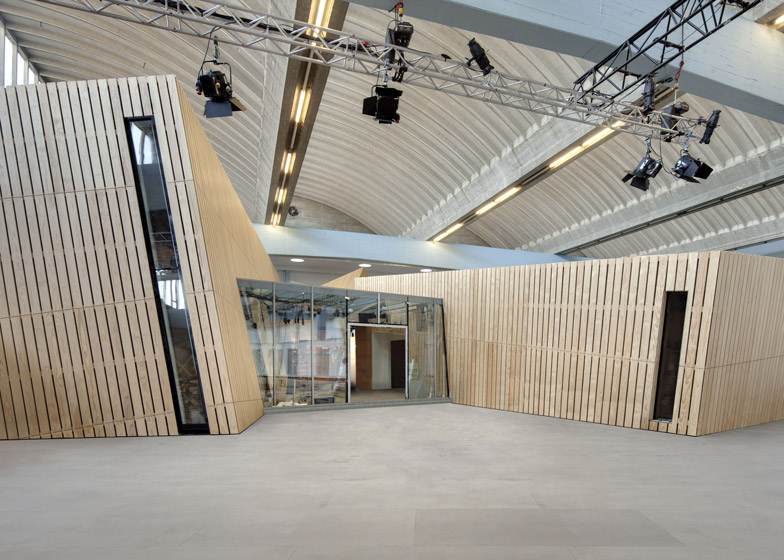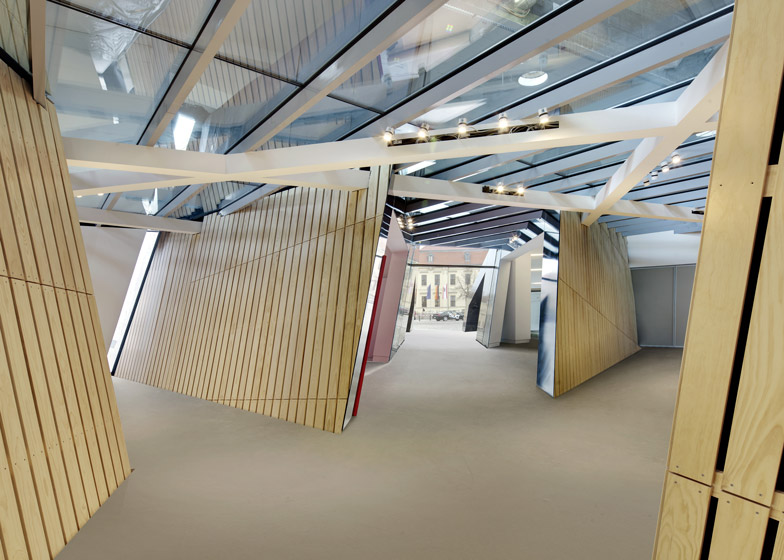Daniel Libeskind has completed an education centre at the Jewish Museum Berlin, twelve years after the American architect completed his widely acclaimed extension (+ slideshow).
Located across the street within the structure of Berlin's old flower market, the Academy of the Jewish Museum Berlin provides a new home to the museum's library and archive, which has doubled in size over the last decade to accommodate both printed and digital records.
At the entrance, Libeskind has designed a roughly-hewn timber box that bursts through the exterior wall, with angular skylights and a sliced opening to invite visitors inside. Two additional timber boxes are located within the building and house the library and auditorium.
The 2300-square-metre centre will be used as a venue for educational workshops, lectures and conferences, and will also offer a meeting place for the 7000 guided tours run by the museum each year.
The Jewish Museum Berlin is one of the largest museums of Jewish history in Europe and opened to the public in 2001, following the construction of Libeskind's extension to the original 1930s building.
"My ongoing collaboration with the Jewish Museum Berlin is a source of tremendous professional and personal pride," said Daniel Libeskind. "Each project offers a fresh chance to illuminate Jewish history and culture, to understand the tragedies and the triumphs, and to celebrate the resilience, creativity and erudition that have been Jews’ enduring legacy."
This year Libeskind was also selected to design a peace centre on the site of a former prison in Northern Ireland and completed a family of curved towers in Singapore.
See more stories about Daniel Libeskind »
Photography is by Bitter Bredt.
Here's some more information from Studio Daniel Libeskind:
The Academy of the Jewish Museum Berlin Will Be Forum for Research, Discussion and Education
Roughly a dozen years after Daniel Libeskind's extension to the Jewish Museum Berlin opened to great acclaim in 2001, the museum has unveiled its latest collaboration with the architect, the Academy of the Jewish Museum Berlin.
The 25,000-square-foot, one-storey Academy stands on the site of Berlin’s one-time flower market, whose shell undergirds the new structure. Located across from the museum proper, the Academy brings together its library, archives and education center and offers additional office, storage and support space for the museum.
Since the museum’s reopening in 2001, its public and educational programs have more than doubled. In addition to 7,000 guided tours each year, the museum offers more than 400 educational programs ranging from workshops for children to training courses for museum professionals. The new facility will house these programs as well as symposia, conferences, lectures and seminars.
The museum’s library and archives have also moved to the Academy. The archives, which contain both printed and audio-visual materials, have also doubled in size over the last decade while the library’s holdings have tripled.
In-Between Spaces
Daniel Libeskind’s design for the Academy of the Jewish Museum Berlin links the building to the museum’s other structures and open spaces, both thematically and structurally.
One of the first things visitors see upon entering the piazza leading to the building are the words of the great medieval Jewish scholar and philosopher Moses Maimonides. His famous adjuration, "Hear the truth, whoever speaks it," is splashed across the left side of the façade, a reminder that those who delve into history must be prepared to accept what they find regardless of the source. The five languages in which the charge is given – English, German, Hebrew, Arabic and the original Judeo-Arabic of medieval Spain – reinforce that message while also suggesting the universal nature of truth.
On the right, a large downward-sloping cube bursts through the façade. Its unusual contours echo the jagged shape of the museum’s 2001 extension, designed by Mr. Libeskind and visible across the street. That shape is also a variation on a theme found in the museum’s Garden of Exileand Glass Courtyard, also designed by Mr. Libeskind and opened 2007 and 2005, respectively.
Two large skylights, visible from the piazza, rest atop the cube. Shaped like the Hebrew letters Alef and Bet (A and B), they are another reminder of the importance of learning and knowledge to the human experience and of their centrality to Jewish life.
After passing through a large gash in the cube that serves as the Academy’s entryway, visitors are decanted into transitional space comprising two more huge cubes. Thrust forward at odd angles, the cubes, which house the library and the auditorium, form a jagged triumvirate with the rear end of entrance cube.
The movement and interaction suggested by the cubes’ shape and placement and by the seemingly rough-hewn timber (actually radiate pine timber) used to fabricate them suggests the sort of crates used to transport precious objects, including books. They also suggest Noah’s Ark, which preserved the most precious thing of all – living beings, in all their splendid variety – during the most important voyage in biblical history.
"In-Between Spaces," Mr. Libeskind’s name for his design, describes the transitional area among the three cubes. It also alludes to the different perspectives offered by that unique vantage point. Standing on that spot, looking into the hall and out on to museum’s other structures and spaces, visitors are ideally placed to reflect on the museum’s larger purpose and their own experience of it.




